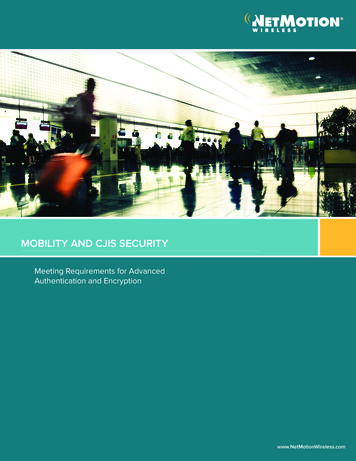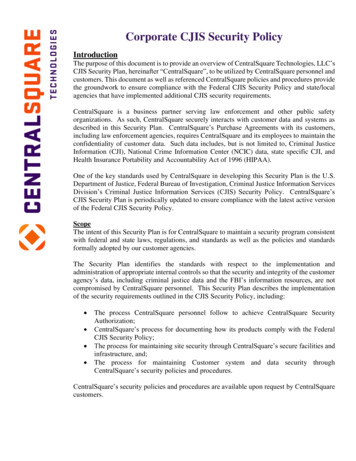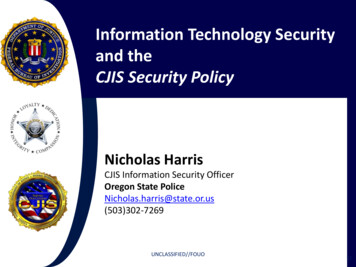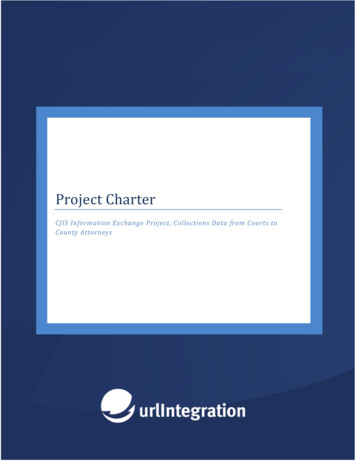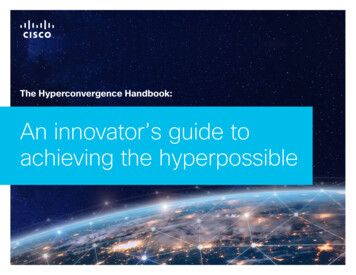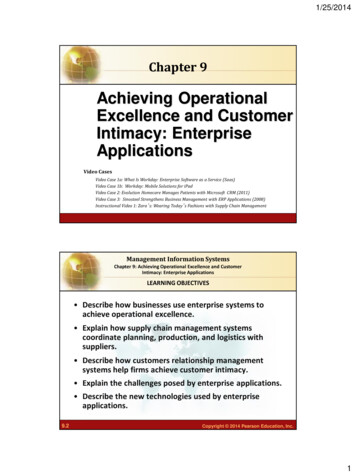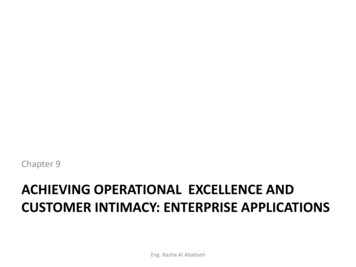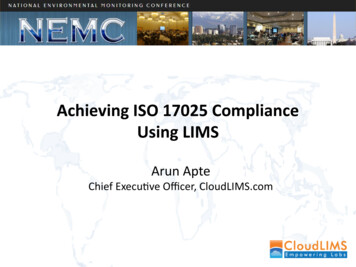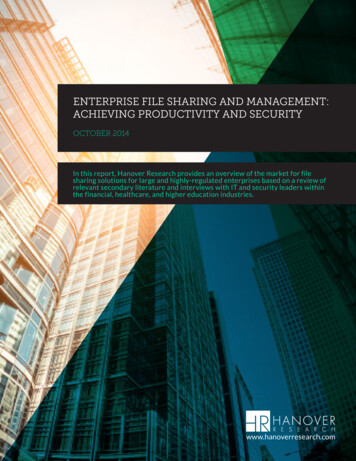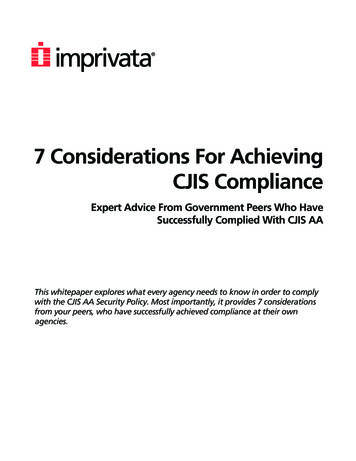
Transcription
7 Considerations For AchievingCJIS ComplianceExpert Advice From Government Peers Who HaveSuccessfully Complied With CJIS AAThis whitepaper explores what every agency needs to know in order to complywith the CJIS AA Security Policy. Most importantly, it provides 7 considerationsfrom your peers, who have successfully achieved compliance at their ownagencies.
7 CONSIDERATIONS FOR ACHIEVING CJIS COMPLIANCE1TABLE OF CONTENTSINTRODUCTION—CJIS AA SECURITY POLICY 2CJIS AA SECURITY POLICY REQUIREMENTS—WHAT YOU NEED TO KNOW 2WHAT IS ADVANCED AUTHENTICATION? 2WHO IS ADVANCED AUTHENTICATION A REQUIREMENT FOR? 2WHAT IS CJIS’ AUDITING REQUIREMENT? 3WHY COMPLY NOW? 37 CONSIDERATIONS FOR COMPLYING WITH CJIS AA 4IMPRIVATA ONESIGN —A SIMPLE SOLUTION TO COMPLEX CJIS REQUIREMENTS. 5 2010 Imprivata, Inc.
7 CONSIDERATIONS FOR ACHIEVING CJIS COMPLIANCE2INTRODUCTION—CJIS AA SECURITY POLICYThe U.S. Federal Bureau of Investigation’s (FBI) Criminal Justice Information Services (CJIS) Divisionnow requires strong passwords and advanced authentication (AA) technology to secure access to CJISinformation and systems. While law enforcement officials require near-instant access to informationprovided by CJIS, maintaining the security of this information is imperative to ensure that data is neveraccessed by unauthorized individuals.Recognizing the competing objectives of timely access and strict security, the FBI has mandated compliancewith the CJIS Security Policy, which provides requirements and guidelines for accessing CJIS information.This policy applies to every agency and individual with access to CJIS systems. Improper access of criminaljustice information can result in administrative sanctions including termination of services and criminalpenalties.CJIS AA SECURITY POLICY REQUIREMENTS—WHAT YOU NEED TO KNOWKey provisions of the CJIS Security Policy are focused on authentication and auditing. The main CJISmandates specify that all law enforcement officials connecting to CJIS systems via wireless networks mustuse: Unique IDs and strong passwords by September 30, 2010oo The CJIS Security Policy states that agencies must use unique IDs and strong passwords bySeptember 30, 2010. Specifically, passwords shall:ooBe a minimum length of eight (8) characters on all systems.ooNot be a dictionary word or proper name.ooNot be the same as the Userid.ooExpire within a maximum of 90 calendar days.ooNot be identical to the previous ten (10) passwords.ooNot be transmitted in the clear outside the secure location.ooNot be displayed when entered. Advanced authentication by September 30, 2013WHAT IS ADVANCED AUTHENTICATION?Advanced authentication (AA) provides additional security to accessing CJIS data by confirming the identityof a user beyond a username and password. In order to satisfy AA requirements, agencies must use twofactor authentication to authenticate users. Approved means of two-factor authentication include fingerbiometrics, smart cards and tokens. Regarding AA, the CJIS policy specifically states:5.6.2.2 Advanced Authentication:Advanced Authentication (AA) provides for additional security to the typical user identification andauthentication of login ID and password, such as: biometric systems, user-based public key infrastructure(PKI), smart cards, software tokens, hardware tokens, paper (inert) tokens, or “Risk-based Authentication”that includes a software token element comprised of a number of factors, such as network information,user information, positive device identification (i.e. device forensics, user pattern analysis and user binding),user profiling, and high-risk challenge/response questions.WHO IS ADVANCED AUTHENTICATION A REQUIREMENT FOR?Advanced Authentication is a requirement for the following: All mobile systems, including laptops (removed from squad cars) and all mobile devices, such as cellphones and PDAs, that run National Crime Information Center (NCIC) access transactions Any device that uses the Internet, wireless, or dial-up connections to run or process NCICtransactions 2010 Imprivata, Inc.
37 CONSIDERATIONS FOR ACHIEVING CJIS COMPLIANCEWHAT IS CJIS’ AUDITING REQUIREMENT?The CJIS policy requires auditing to provide integrated reporting capabilities that track data access, networkauthentication, and application activity at the individual user level.Log-on attempts, password changes, and other security-related events, must be securely logged as part ofthe agency’s auditability and accountability controls. These requirements are detailed in Policies 5.6.2.1Policy 5.4.1.1 - Auditable EventsThe following events shall be logged: Successful and unsuccessful system log-on attempts. Successful and unsuccessful attempts to access, create, write, delete or change permission on a useraccount, file, directory or other system resource. Successful and unsuccessful attempts to change account passwords. Successful and unsuccessful actions by privileged accounts. Successful and unsuccessful attempts for users to access, modify, or destroy the audit log file.Imprivata OneSign streamlines the implementation of audit controls by tracking and consolidating thedisparate employee access events outlined in the CJIS Security Policy. With Imprivata OneSign, agenciescan rapidly respond to audit inquiries with real-time, aggregated views of when, how, and from wherean employee gained network and application access. Imprivata OneSign reports show who is sharingpasswords, what applications users are authorized to access, and what credentials they are using. Whenusers leave the agency or are no longer authorized to access CJIS systems, Imprivata OneSign ensures thataccess—across all user accounts—is instantly revoked.WHY COMPLY NOW?Rather than waiting for the 2013 deadline, there are numerous advantages to complying with CJIS now.These include:System UpgradeThough a deadline of September 2013 may appear to provide plenty of time for organizations to meet theCJIS advanced authentication requirements, in practice it does not. Any agency considering or planningto acquire or upgrade a system that links to CJIS information must implement AA for that system as it isdeployed—even if it is placed into service prior to 2013.AuditingMany of the CJIS authentication and auditing requirements are currently being mandated independentlyat the state and local levels. By implementing a solution to address these requirements now, agencies cansimultaneously achieve CJIS compliance.Grants and FundingGrants and Funding are available for many agencies. As the 2013 deadline approaches, competition forfunding at the local, state, and federal levels will increase dramatically. Grants and budget dollars availabletoday may not be available as the cut-off date for compliance nears. Agencies are also implementingadvanced authentication early to meet other state and local government mandates, or simply because it’s abest practice.Ultimately, unique IDs, strong passwords, advanced authentication, and audit controls are best practicesthat every organization should be planning to adopt. The FBI requires their use because they protectsensitive data. Implementing a solution now can help an organization avoid security breaches in the yearsand months before compliance is required. 2010 Imprivata, Inc.
7 CONSIDERATIONS FOR ACHIEVING CJIS COMPLIANCE47 CONSIDERATIONS FOR COMPLYING WITH CJIS AAAt times like these, you need expert advice—not from a vendor, but from actual peers who havesuccessfully complied with CJIS at their own agencies—from those who have measured the results againstthe investment, and can share their experiences. So we approached some of our customers and askedthem what advice they’d give to other agencies who are trying to comply with CJIS AA. What follows are 7considerations for ensuring success based on their experiences.1. CHOOSE A VENDOR THAT SUPPORTS ALL CJIS-APPROVED AUTHENTICATION METHODSThe CJIS Security Policy requires that AA requirements must be supported by the authorized authenticationmethods. These methods include smart cards, electronic token devices, paper/inert tokens and fingerbiometrics. Selecting the best form of two-factor authentication to implement will depend heavily on thespecific needs of the organization. It’s important to keep in mind that those needs can vary over time andacross the organization, and deploying a solution with limited options will likely not serve all groups well.2. CONSIDER HOW SECOND FACTOR AUTHENTICATION WILL AFFECT OFFICER WORKFLOWSWhen choosing a solution, agencies must consider how implementing second factor authentication willeffect officer workflows. In the fast-paced environment of law enforcement, it is imperative that secondfactor authentication does not disrupt officer workflows or productivity. Choose a solution that requiresofficers to only provide second factor authentication only once during their shift, and save time with agrace period.3. EXAMINE WHETHER YOU NEED A VIRTUAL OR PHYSICAL APPLIANCEThe latest authentication software support both physical and virtual desktop environments. Considerwhether or not your department is looking to move to a virtual desktop environment when evaluatingsolutions, or if your department prefers a physical, hardened appliance.4. CONSIDER A SOLUTION THAT REQUIRES NO SCHEMA EXTENSIONS OR OTHER MODIFICATIONS TOEXISTING LDAP DIRECTORYWhen an agency is under pressure to meet CJIS guidelines—either because it is upgrading a major systemor to meet a state or federally-mandated deadline—the last thing it needs is to further disrupt the ITenvironment with changes to its directory or infrastructure. Choose a solution that fits easily into existing ITinfrastructions in order not to disturb workflows.5. ENSURE YOUR SOLUTION PROVIDES END-TO-END COMPLIANCE WITH THE FIPS 140-2 DATA ENCRYPTIONSTANDARDCJIS requires FIPS 140-2 compliance for biometric systems and criminal justice information stored ortransmitted outside physically secured locations. Ensure that the biometrics you choose comply with theFIPS 140-2 Standard.6. CHOOSE A SINGLE PLATFORM SOLUTION THAT SUPPORTS CAPABILITIES FOR SELF-SERVICE RESET OFDIRECTORY PASSWORDSConsider the effect of the new policy on law enforcement agents and the IT helpdesk. While it’s relativelyeasy to mandate longer passwords that expire, personnel will have a more difficult time rememberingpasswords for each of the many applications they need to access. The result will be increased passwordreset requests to the helpdesk.7. CHOOSE A SINGLE PLATFORM SOLUTION THAT SUPPORTS SINGLE SIGN-ON TO ALL APPLICATIONSConsider a solution that also enables single sign-on to all applications. With single-sign on, agencies canprofile an application’s sign-on behaviors and enable application profiling without scripting or modificationof application code. 2010 Imprivata, Inc.
57 CONSIDERATIONS FOR ACHIEVING CJIS COMPLIANCEIMPRIVATA ONESIGN —A SIMPLE SOLUTION TO COMPLEX REQUIREMENTSImprivata OneSign offers a simple solution to complex CJIS requirements that can be implemented today.Furthermore, it enables organizations to meet CJIS secuirty requirements while streamlining—ratherthan hindering—access to vital information for officers and reducing the workload on already overtaxedhelpdesk and IT departments.Beyond fulfilling the vital password, advanced authentication, and event auditing requirements of hteCJIS Security Policy, Imprivata OneSign offers a broad range of benefits to law enforcement, public safety,judicial, and probation/correctional organizations.CONSIDERATIONIMPRIVATA ONESIGNVENDOR SUPPORTS ALL CJIS-APPROVEDAUTHENTICATION METHODSSupports a wide range of CJIS-approved advancedauthentication technologies: Multiple card types – Supports activeand passive proximity cards, Windowssmart cards, building access cards, andgovernment ID card technologies fromleading vendors. Finger biometrics – Supports fingerprintbiometrics and works with readersembedded in laptops as well as USB readersthat can be mixed and matched as neededon workstations. Because ImprivataOneSign is based on a centrally managedarchitecture, agents need enroll theirfingerprint just once, no matter how manyworkstations they access. Tokens – Includes a built-in RADIUS serverto handle remote access authenticationusing DIGIPASS tokens by VASCO, RSASecurID tokens, Secure Computing tokens,or passwords.CONSIDER HOW SECOND FACTORAUTHENTICATION WILL AFFECT OFFICERWORKFLOWSMinimizes officer disruption by allowing officersto authenticate via 2 factor (i.e. password plusbiometric swipe) at the start of their shift and“unlock” their workstation with a fingerprintalone.VIRTUAL OR PHYSICAL APPLIANCEBecause it is designed for rapid enterprisedeployment and easy integration, ImprivataOneSign’s appliance-based solution can beimplemented quickly and with minimal installationcosts—key requirements for most organizationsseeking CJIS compliance.REQUIRES NO SCHEMA EXTENSIONS OR OTHERMODIFICATIONS TO EXISTING LDAP DIRECTORYRequires no changes to user directories,applications, or physical access control systems, anddoes not require additional staffing or specializedmanagement skills. The Imprivata OneSignplatform is designed to fit easily into existing ITinfrastructures and workflows, and is managedfrom a single, easy-to-use Web-based administrativeconsole. 2010 Imprivata, Inc.
7 CONSIDERATIONS FOR ACHIEVING CJIS COMPLIANCE6CONSIDERATIONIMPRIVATA ONESIGNEND-TO-END COMPLIANCE WITH THE FIPS 140-2DATA ENCRYPTION STANDARDMeets all Federal Information Processing Standards(FIPS) 140-2 encryption and data protectionrequirements.SINGLE PLATFORM SUPPORTS CAPABILITIES FORSELF-SERVICE RESET OF DIRECTORY PASSWORDSOfficers need to remember only one password, andwith self-service password management, they caneasily reset their own passwords without helpdeskintervention. Imprivata OneSign enables agenciesto meet CJIS password management requirementswhile streamlining officer access to CJIS data,reducing the IT helpdesk burden, and automatingthe password change processes for all applications.SINGLE PLATFORM SUPPORTS SINGLE SIGN-ON TOALL APPLICATIONSEnables single sign-on to all applications: CJIS,web, client-server, Java, and legacy terminalemulators. Using a simple, drag-and-dropinterface, administrators can dynamically profilean application’s sign-on behaviors, enablingrapid application profiling without scripting ormodification of application code—and with nodirectory changes.To learn more about Imprivata’s solution for CJIS, please e-mail sales@imprivata.com with “CJIS” in thesubject line, or visit our website at “www.imprivata.com”. 2010 Imprivata, Inc.
Offices In:Belgium GermanyItaly SingaporeUK USA1 877 ONESIGN1 781 674 2700www.imprivata.comWP-CJIS-Ver1-09-2010
Advanced authentication by September 30, 2013 WHAT IS ADVANCED AUTHENTICATION? Advanced authentication (AA) provides additional security to accessing CJIS data by confirming the identity of a user beyond a username and password. In order to satisfy AA requirements, agencies must use two-factor authentication to authenticate users.
